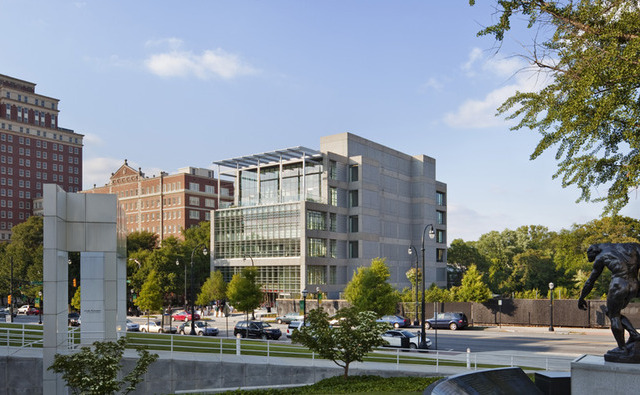
A renovated building in Midtown Atlanta has been awarded 95 out of a possible 110 LEED points for its environmental design-the highest score for any new construction in the Northern Hemisphere.
Though classified as a "New Construction" in the Leadership in Energy and Environmental Design system, 1315 Peachtree Street, Atlanta is actually a 1980s construction that has undergone extensive renovation. But what does LEED certification entail? And is this the greenest building in the Northern Hemisphere?
According to the architect, Perkins+Will, who are both the designers and occupants of the renovated building, a variety of technologies were employed to help achieve Platinum certification. A trigeneration system (providing electricity, heating and cooling) is foremost among them, employing gas microturbines on the roof generating both electricity and heat. Some of that heat drives an absorption chiller providing the building's cooling. Daylight harvesting and LED lighting are among the measures which have reduced the building's energy consumption by a claimed 58 percent from baseline figures. Rainwater harvesting has cut the consumption of supplied water by 78 percent. Both figures are well above that required to achieve maximum points in their respective criteria.
LEED essentially provides a collection of yardsticks next to which some of a building's green credentials can be measured. Eighty points are sufficient to win Platinum status in version 3 of the system, which has been in use since 2009, and is the version with which 1315 Peachtree Steet was scored. Platinum is the highest of four levels of certification, followed by Gold, Silver and, yes, Certified.
One hundred of the available points are spread over five categories with the largely self-explanatory titles Energy and Atmosphere (worth 35 points), Water Efficiency (10), Materials and Resources (14), Sustainable Sites (26), and Indoor Environmental Quality (15). An additional six bonus points are available for "innovation in design", and the final four are for "Regional Priority"—or measures that address localized environmental issues. One of the "innovation in design" points is available for the involvement of a LEED-accredited professional in the design—a point which has no direct bearing on the greenness (or otherwise) of the building at hand. A full breakdown of the points system, and an explanation of the criteria, is available on the US Green Building Council's website.
To achieve LEED certification, building owners must cough up registration and certification fees to the US Green Building Council, and provide documentary evidence of compliance with the scheme, which is verified by the Council. The process is purely voluntary, meaning that buildings with extremely environmentally-sound design may go uncertified. However, LEED-certification is increasingly being encouraged and even mandated at state level, and within federal agencies.
According to the US Green Building Council's Certified Project Directory, 245 projects have been assessed under the same system and category (LEED-NC v2009), and of those 25 have been awarded a Platinum certificate. So, of the nearly-10,000 projects LEED-certified in the US alone, 1315 Peachtree Street is only directly comparable to 245.
LEED 2009 places a greater emphasis than ever before on energy reduction, but is criticized in some quarters for not going far enough. A relatively whopping 19 points—the single biggest allocation—are available for optimized energy performance. In new buildings the full points haul requires energy savings of 48 percent in comparison to a theoretical baseline. By contrast the Architecture 2030 program calls for a minimum reduction of 60 percent, measured against regional averages rather than theoretical data. If buildings are now close to maxing out on the LEED scoring system, perhaps a general raising of expectations is merited.
Of greater concern is the suggestion that LEED-certified buildings do not always save the amounts of energy that is claimed. Savings are established by the building designer who measures the building design against a minimum requirement (ASHRAE Standard 90.1 - Energy Standard for Buildings Except Low-Rise Residential Buildings). What that minimum standard specifically entails will vary from building to building, and is quantified by the buildings designer through computer modeling.
Doubt would be reduced by verification of certification based on real-world use once the building is occupied. An assessment based on design data would still be required (where final planning permission is dependent on LEED certification, for instance), but the status would be provisional. The technology is already available to do this relatively painlessly through the remote reading of meter data via the 'Net. Were LEED to adopt such an approach, there's no reason that LEED certification could not become a live status requiring maintenance over time rather than being the one-off badge of honor that it is. Financial penalties for design assessments that fall well short of the reality may help the problem of optimistic LEED assessments—if such a problem exists.
Though scorecards under older certification systems are available from the project directory, none for the 245 projects in 1315 Peachtree Street's category are. But without the documentary evidence used to establish the LEED rating, and real-world performance data to compare it to, the information that could be gleaned would be extremely limited in any case.
A LEED score of 95 points suggests that a building should be extremely environmentally friendly, but the only conclusion that can be drawn with absolute certainty is that its design is adept at passing LEED tests. In 1315 Peachtree Street's case, it, of all the buildings in the Northern Hemisphere, is the LEEDiest of 245.
The US Green Building Council has not responded to our request to see 1315 Peachtree Street's LEED assessment, and the architect declined to respond to our technical queries about the specifics of the renovation.
Listing image by Image courtesy of Perkins+Will
reader comments
44